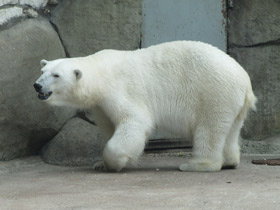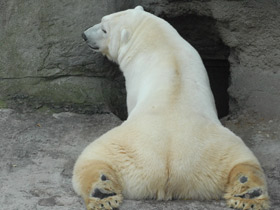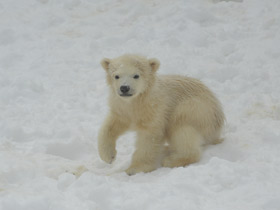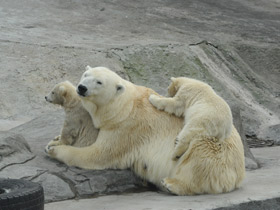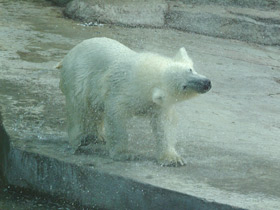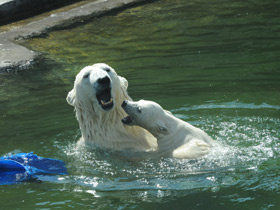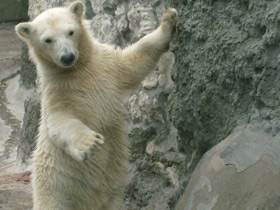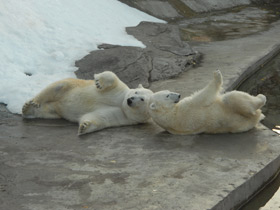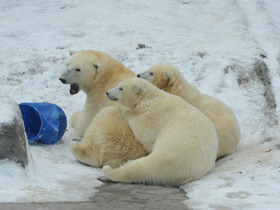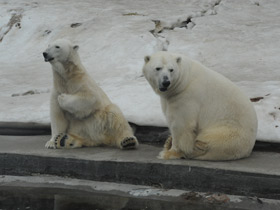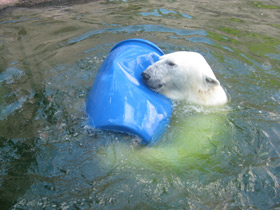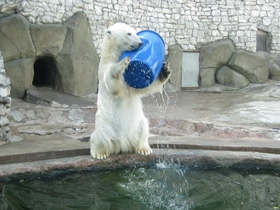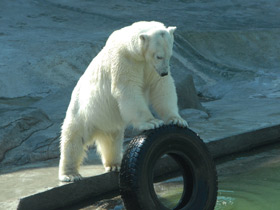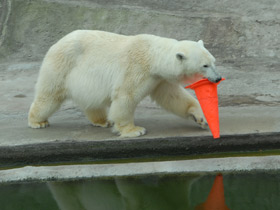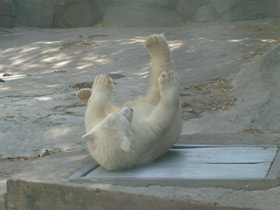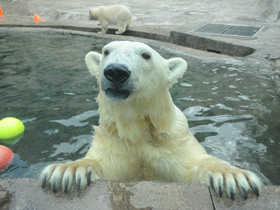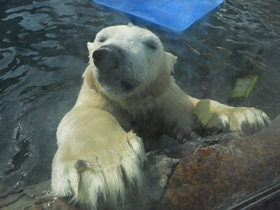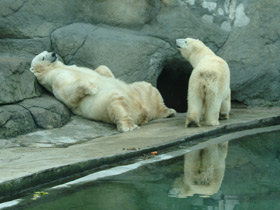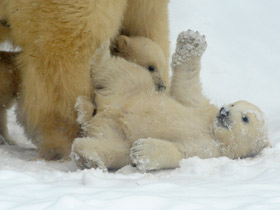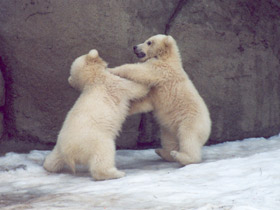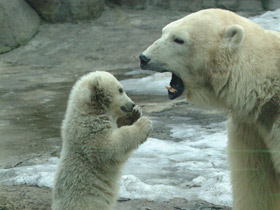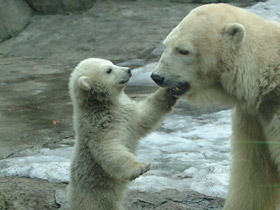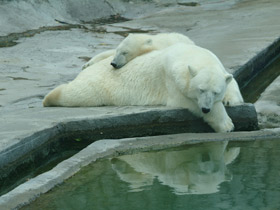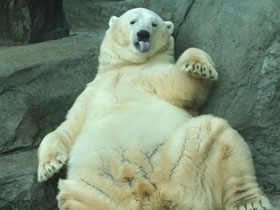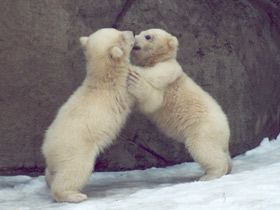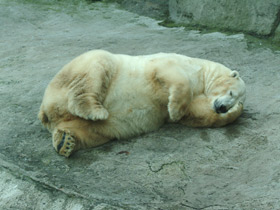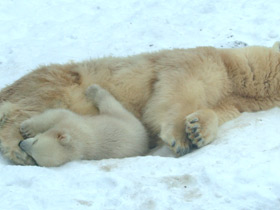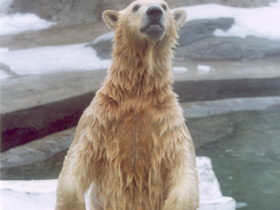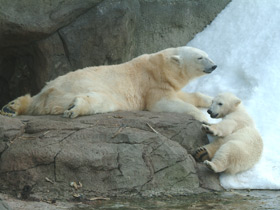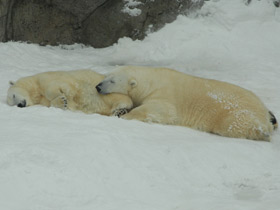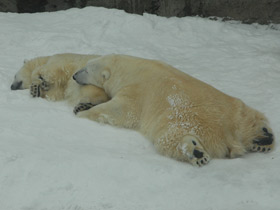The polar bear (Ursus maritimus)
 The polar bear (Ursus maritimus) is on the Russian Red List
The polar bear (Ursus maritimus) is on the Russian Red List
 The polar bear (Ursus maritimus) is included in the IUCN Red List as a "vulnerable species"
The polar bear (Ursus maritimus) is included in the IUCN Red List as a "vulnerable species"
The polar bear (Ursus maritimus) is a large bear native to the Arctic and nearby areas. It is closely related to the brown bear, and the two species can interbreed.
Naming
The polar bear was given its common name by Thomas Pennant in A Synopsis of Quadrupeds (1771). It was known as the "white bear" in Europe between the 13th and 18th centuries, as well as "ice bear", "sea bear" and "Greenland bear". The Norse referred to it as isbjørn ("ice bear") and hvitebjørn ("white bear"). The bear is called nanook by the Inuit. The Netsilik cultures additionally have different names for bears based on certain factors, such as sex and age: these include adult males (anguraq), single adult females (tattaq), gestating females (arnaluk), newborns (hagliaqtug), large adolescents (namiaq) and dormant bears (apitiliit). The scientific name Ursus maritimus is Latin for "sea bear".
Taxonomy
Carl Linnaeus classified the polar bear as a type of brown bear (Ursus arctos), labelling it as Ursus maritimus albus-major, articus in the 1758 edition of his work Systema Naturae. Constantine John Phipps formally described the polar bear as a distinct species, Ursus maritimus in 1774, following his 1773 voyage towards the North Pole. Due to its adaptations to a marine environment, some taxonomists like Theodore Knottnerus-Meyer have placed the polar bear in its genus Thalarctos. However Ursus is widely considered to be the valid genus for the species based on the fossil record and the fact that it can breed with the brown bear.
Different subspecies have been proposed including Ursus maritimus maritimus and U. m. marinus. However these are not supported and the polar bear is considered to be monotypic. One possible fossil subspecies, U. m. tyrannus, was posited in 1964 by Björn Kurtén, who reconstructed the subspecies from a single fragment of an ulna which was approximately 20 percent larger than expected for a polar bear. However, re-evaluation in the 21st century has indicated that the fragment likely comes from a giant brown bear.
Distribution and description
Ursus maritimus is a species of carnivorous mammal of the bear family (Ursidae). Along with its relative, the Kodiak bear (Ursus arctos middendorffi), it is one of the largest terrestrial carnivores on Earth.
The polar bear's permanent habitat is the coastal ice of continents and islands and a narrow strip of Arctic coastline. This rare animal is included in the IUCN Red List and the Russian Red Data Book. Ursus maritimus is the largest animal not only among bears, but also among all predators. Some males are up to 3 m long, 1.5 m high at the withers and weigh 800 kg; females are smaller and lighter.
Ursus maritimus has an elongated body, narrow at the front and massive at the back, a long, mobile neck and a relatively small head with small eyes and ears. Its huge front legs are used as paddles when swimming, while the hind legs act as rudders. A thick, pure white coat camouflages this polar predator perfectly against the snowy background and allows it to approach its prey unnoticed (photo 1, 2, 3, 4, 5, 6).
A 3 to 4 cm thick layer of fat not only protects the Ursus maritimus from the cold and serves as an energy store, but also lightens its body, allowing it to float easily.
Nutrition
Ursus maritimus is the only member of the family that feeds almost exclusively on meat. Its main prey is fur seals, but it also hunts walruses, beluga whales, narwhals and seabirds. The polar bear surpasses almost all mammals in olfactory acuity: it can smell its prey under a metre-long layer of ice and snow. This extraordinarily intelligent predator assesses its environment with great precision and, depending on the situation, uses a variety of hunting methods. It can spend hours hunting pinnipeds near a hole, covering its black nose with a paw to camouflage them, or crawling slowly towards a seal lying on an ice floe to make a quick and accurate shot, or swimming to its prey and climbing up the ice to block its path to the life-saving water. The bear kills its prey with a powerful blow to the foreleg, and with its amazing strength can drag a walrus carcass weighing more than a tonne to shore in a single move.
Breeding
In the middle of the Arctic winter, Ursus maritimus gives birth to 1 to 3 small, deaf and blind pups covered in a scanty whitish coat, defenceless and tiny. Their body length is 17-30 cm, their weight is 500-700 g and they are insignificant compared to a female bear. The fact is that the female bear does not feed all winter and lives on its fat reserves: at the end of this forced hunger strike it loses almost half of its weight. Under such conditions, the female would certainly not be able to feed her larger cubs.
The young develop very slowly: they are not able to see and hear until after a month of age, and their teeth emerge after a month. By then, the young begin to leave the den, but they can only follow their mother at 3 months.
Males not only do not help females raise their young, but may sometimes eat them: cannibalism is not uncommon in Ursus maritimus. The mother's care of her young does not cease until they are fully self-sufficient and have mastered the complex art of foraging.
After two years, mother and calves become almost equal in size (young males even outnumber their mothers), at which point they are separated.
Photos 7-29 show the young as they grow and photo 17 shows a female feeding her young with milk.
Mortality
Polar bears can live up to 30 years. The bear's long lifespan and ability to consistently produce young offsets cub deaths in a population. Some cubs die in the dens or the womb if the female is not in good condition. Nevertheless, the female has a chance to produce a surviving litter the next spring if she can eat better in the coming year. Cubs will eventually starve if their mothers cannot kill enough prey. Cubs also face threats from wolves and adult male bears. Males kill cubs to bring their mother back into estrus but also kill young outside the breeding season for food. A female and her cubs can flee from the slower male. If the male can get close to a cub, the mother may try to fight him off, sometimes at the cost of her life.
Subadult bears, who are independent but not quite mature, have a particularly rough time as they are not as successful hunters as adults. Even when they do succeed, their kill will likely be stolen by a larger bear. Hence subadults have to scavenge and are often underweight and at risk of starvation. At adulthood, polar bears have a high survival rate, though adult males suffer injuries from fights over mates. Polar bears are especially susceptible to Trichinella, a parasitic roundworm they contract through cannibalism.
Relationship with humans
Polar bears have coexisted and interacted with circumpolar peoples for millennia. "White bears" are mentioned as commercial items in the Japanese book Nihon Shoki in the seventh century. It is not clear if these were polar bears or white-coloured brown bears. During the Middle Ages, Europeans considered white bears to be a novelty and were more familiar with brown- and black-coloured bears. The first known written account of the polar bear in its natural environment is found in the 13th-century anonymous Norwegian text Konungs skuggsjá, which mentions that "the white bear of Greenland wanders most of the time on the ice of the sea, hunting seals and whales and feeding on them" and says the bear is "as skillful a swimmer as any seal or whale".
Conflicts
When the sea ice melts, polar bears, particularly subadults, conflict with humans over resources on land. They are attracted to the smell of human-made foods, particularly at garbage dumps and may be shot when they encroach on private property. In Churchill, Manitoba, local authorities maintain a "polar bear jail" where nuisance bears are held until the sea ice freezes again. Climate change has increased conflicts between the two species. Over 50 polar bears swarmed a town in Novaya Zemlya in February 2019, leading local authorities to declare a state of emergency.
Ursus maritimus in zoos
In zoos, bears (like other animals) do not have to travel long distances to find food or a mate, nor do they have to hide from predators. As a result, they have a lot of free time, which they have nothing to occupy, and the animals become bored and even sick. To entertain them and allow them to display their natural behaviour, zoos use various methods to enrich their habitat; for example, by giving the animals a variety of toys that they enjoy playing with - see photos 30, 31, 32, 33.









